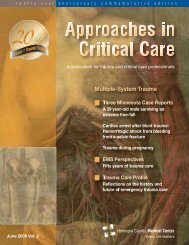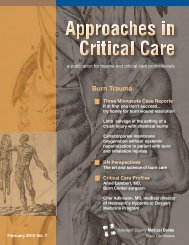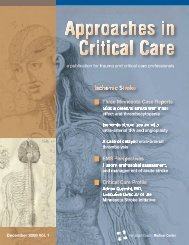Pediatric Trauma - Hennepin County Medical Center
Pediatric Trauma - Hennepin County Medical Center
Pediatric Trauma - Hennepin County Medical Center
You also want an ePaper? Increase the reach of your titles
YUMPU automatically turns print PDFs into web optimized ePapers that Google loves.
Technology in Critical Care<br />
Technology in Critical Care: Radiation risks from<br />
computed tomography<br />
by Gopal Punjabi, MD<br />
Department of Radiology<br />
<strong>Hennepin</strong> <strong>County</strong> <strong>Medical</strong> <strong>Center</strong><br />
Introduction<br />
The last 40 years have seen dramatic advances in<br />
medical imaging that have revolutionized clinical<br />
medicine. The benefits include more effective<br />
diagnosis, shorter hospital stays, and elimination of<br />
exploratory surgery and rapid diagnosis of lifethreatening<br />
conditions 1 . For example, the trauma<br />
patient can undergo a highly accurate whole-body<br />
computed tomography (CT) scan within a few<br />
minutes that often replaces multiple invasive<br />
examinations, such as angiography and exploratory<br />
laparotomy. This has also lead to an increase in<br />
radiation dose delivered to the patient population.<br />
There has been considerable interest in the medical<br />
literature and in the lay press regarding radiation<br />
dose, often with alarming headlines. In this article,<br />
the biological effects of low-dose ionizing radiation<br />
and methods to reduce radiation risks in CT scanning<br />
will be discussed.<br />
Background<br />
Computed tomography scan is a relatively recent<br />
intervention, developed in the late 1960s by EMI,<br />
Ltd., a music, electronics and leisure company based<br />
in the United Kingdom, funded by profits from the<br />
Beatles' recordings. Sir Godfrey Hounsfield, a British<br />
engineer and Allan Cormack, a physicist born in<br />
South Africa, received the Nobel Prize for this<br />
invention in 1979 2 . The CT scanner uses ionizing<br />
radiation to produce highly detailed images. There<br />
has been rapid advancement in CT technology since<br />
its invention, with current scanners using multidetector<br />
helical technology. This involves an X-ray<br />
beam going through the patient and detected on the<br />
opposite side by multiple detector rows, enabling<br />
sub-second imaging of large portions of human body.<br />
With rapid innovations, the use of CT scans has<br />
dramatically exploded. While in 1980 about 3 million<br />
CT scans were performed, the projection for 2011 is<br />
72 million CT scans. This trend is likely to increase<br />
with an aging population, as well as multiple new<br />
applications of CT, such as CT virtual colonoscopy,<br />
coronary CT angiography, and CT perfusion<br />
scanning.<br />
Radiation dose<br />
Radiation dose describes the amount of energy<br />
absorbed per unit mass at a specific point, and is<br />
expressed in Grays (1 Gy deposits 1 Joule per<br />
kilogram). This does not reflect risk; for instance, a<br />
100 mGy dose to an extremity would not have the<br />
same biological effect as the same dose to the<br />
pelvis. A more useful measurement is the effective<br />
dose, which takes into account the biological<br />
sensitivity of the tissue or organ being irradiated, and<br />
is calculated by multiplying the radiation dose with<br />
tissue and radiation weighing factors 3 . The unit of<br />
effective dose is the Sievert (usually millisieverts<br />
(mSv) are used in diagnostic radiology). The use of<br />
the effective dose facilitates communication with the<br />
patient, and understanding of the likelihood of<br />
potential harm from the radiological exam. The<br />
effective dose is a theoretical number that cannot be<br />
directly measured.<br />
The annual level of naturally occurring background<br />
radiation in the United States is estimated at about<br />
3.1mSv 4 . In 2006, the annual per capita effective<br />
radiation dose from man-made sources was<br />
estimated at about 3.1 mSv; of this, CT accounts for<br />
about 1.47 mSv 5 . The effective dose from an<br />
individual CT scan varies between different body<br />
parts 6 (Table One). There is also tremendous<br />
variation among scanners, depending on the<br />
scanning technique used. For comparison purposes,<br />
the average effective dose from a two-view chest X-<br />
ray is 0.1 mSv, and that from a nuclear cardiac stress<br />
test using technetium 99m labeled sestamibi is about<br />
12.8 mSv.<br />
Procedure<br />
CT Head<br />
CT Chest<br />
CT Abdomen<br />
CT Pelvis<br />
CT Cervical Spine<br />
CT Lumbar Spine<br />
Average Effective Dose<br />
2 mSv<br />
7 mSv<br />
8 mSv<br />
6 mSv<br />
6 mSv<br />
6 mSv<br />
Table One: Radiation doses in common CT exams 6<br />
12 | Approaches in Critical Care | June 2011
















